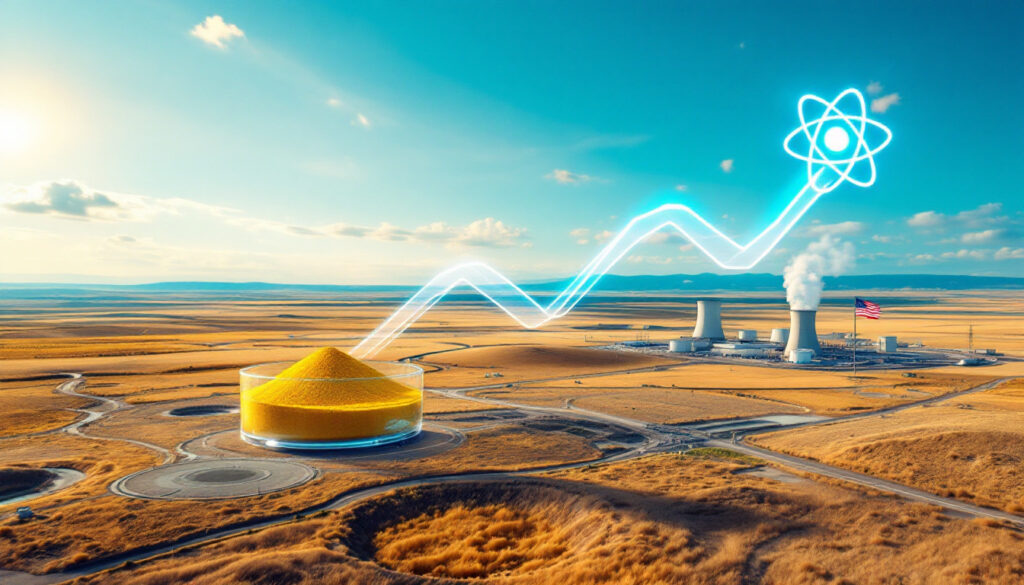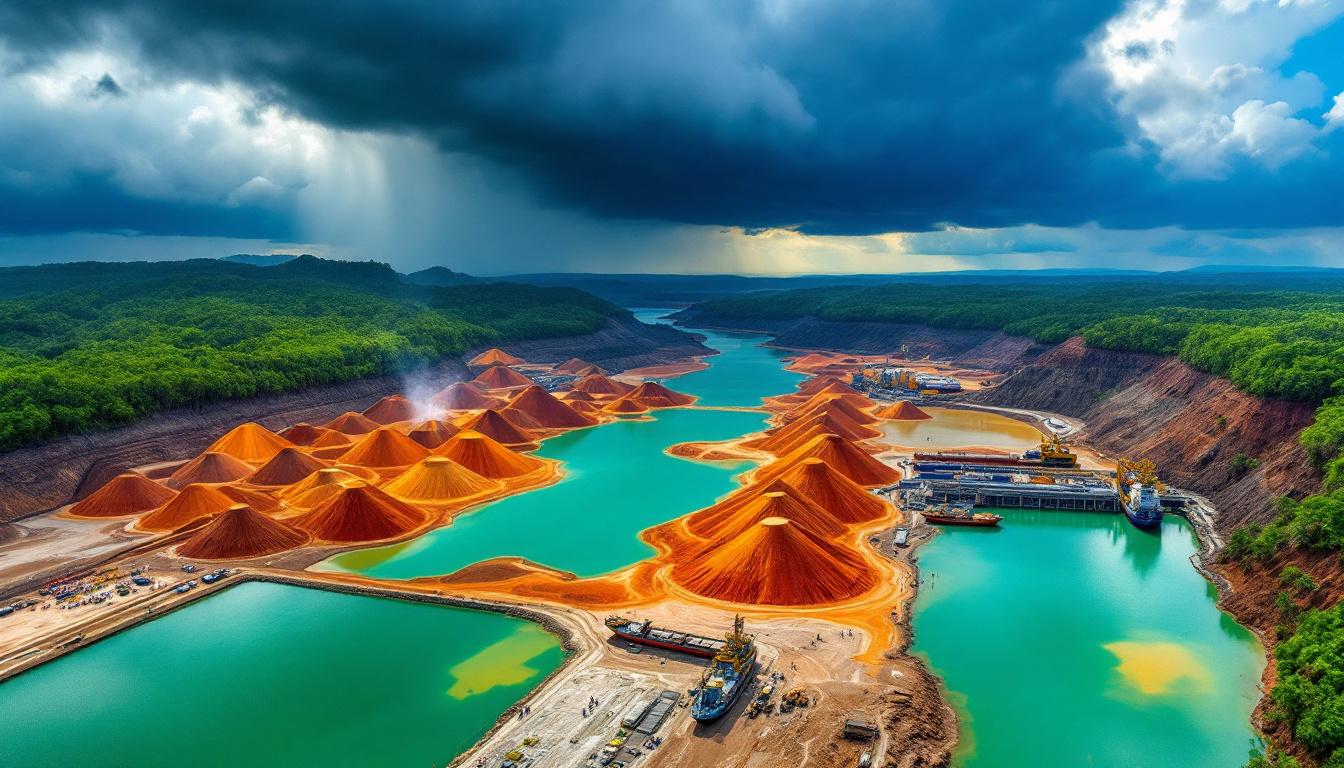US Uranium Concentrate Production in 2024: Record Growth and Industry Outlook
The United States uranium industry has experienced a remarkable resurgence in 2024, with production figures reaching levels not seen since 2018. This revival comes at a critical juncture as the nation seeks to strengthen its energy independence and reduce reliance on foreign uranium sources amid growing global demand for nuclear power.
What is Driving the Resurgence in US Uranium Production?
Six-Year Production High Achieved
US uranium concentrate production in 2024 has reached its highest point in six years, marking a significant milestone for the domestic nuclear fuel supply chain. The fourth quarter of 2024 saw production soar to 375,401 pounds of uranium concentrate, more than tripling the third quarter output of 121,296 pounds. This dramatic increase reflects a renewed focus on domestic uranium production capabilities after years of decline.
Industry analysts attribute this growth to a combination of favorable market conditions and strategic opportunities in uranium investment. According to Mark Chalmers, CEO of Energy Fuels, "The domestic uranium sector is finally seeing the results of years of patient capital allocation and strategic positioning during the prolonged market downturn."
Key Production Facilities Contributing to Growth
The production surge is primarily driven by two types of facilities: in-situ recovery (ISR) operations in Texas and Wyoming, and the conventional White Mesa Mill in Utah. These facilities have ramped up operations in response to improving market conditions and governmental support initiatives.
The White Mesa Mill, operated by Energy Fuels, stands as the only conventional uranium mill currently operational in the United States. This facility has strategically pivoted its production focus toward uranium for 2025, shifting resources from rare earth element processing to capitalize on stronger uranium prices. The mill's unique dual-capability to process both uranium and rare earth minerals provides operational flexibility that few other facilities worldwide can match.
How is Uranium Produced in the United States?
In-Situ Recovery (ISR) Operations
In-situ recovery, the dominant uranium extraction method in the US, accounts for approximately 90% of domestic production. This technique involves injecting a solution into uranium-bearing sandstone formations to dissolve the uranium, which is then pumped to the surface for processing.
Wyoming hosts four active ISR facilities contributing significantly to national production:
- Nichols Ranch ISR Project (operated by Energy Fuels)
- Lost Creek Project (operated by Ur-Energy)
- Ross Central Processing Plant (operated by Peninsula Energy restarts uranium production in Wyoming)
- Smith Ranch-Highland Operation (operated by Cameco)
Meanwhile, Texas contributes through two ISR facilities:
- Alta Mesa Project (operated by enCore Energy)
- Rosita (operated by Uranium Energy Corp)
The geological characteristics of Wyoming's Powder River Basin and South Texas's uranium belt make these regions particularly suitable for ISR operations, with permeable sandstone formations containing uranium deposits at depths of 400-1,500 feet.
Conventional Milling Operations
The White Mesa Mill in Blanding, Utah, stands as America's sole conventional uranium mill, processing hardrock ore through crushing, grinding, and chemical leaching. This facility has recently upgraded its processing circuits to handle both uranium and rare earth minerals, giving it strategic importance in two critical mineral supply chains.
The mill's processing capacity exceeds 2,000 tons of ore per day, making it a cornerstone of US uranium production infrastructure. Its ability to process alternate feed materials, including uranium-bearing waste from other industries, provides additional production flexibility not available at ISR facilities.
What Factors are Influencing Uranium Market Demand?
Growing Energy Needs
The explosive growth of data centers across the United States is creating unprecedented electricity demand, with Meta, Google, Microsoft, and Amazon collectively requiring gigawatts of reliable power. This surge is driving renewed interest in nuclear power as a stable baseload generation source that can operate 24/7 regardless of weather conditions.
Local manufacturing renaissance initiatives, particularly in semiconductor fabrication and electric vehicle production, are further straining existing power grids. According to the Department of Energy, the electrification of transportation and buildings could increase US electricity demand by up to 38% by 2050, creating substantial market opportunities for uranium producers.
Dr. Samuel Johnson, energy economist at MIT, notes: "We're witnessing a perfect storm of energy demand drivers—AI data centers, reshored manufacturing, and electrification—all requiring massive amounts of reliable, carbon-free electricity that only nuclear can realistically provide at scale."
Nuclear Energy Renaissance
The nuclear industry is experiencing a notable revival, with efforts underway to restart completely shuttered reactors—a previously unprecedented move in the industry. Plans include reactivating a reactor at the historic Three Mile Island site in Pennsylvania, marking a symbolic turning point for an industry that has struggled with public perception since the 1979 accident.
Additionally, the federal government has awarded contracts to six companies for domestic uranium fuel production, including Centrus Energy, which became the first US company in 70 years to produce High-Assay Low-Enriched Uranium (HALEU)—a more energy-dense fuel required for next-generation reactor designs.
Small modular reactors (SMRs) are emerging as a promising market for uranium, with NuScale Power receiving design certification from the Nuclear Regulatory Commission and several utilities pursuing deployment plans. These smaller, factory-built reactors could create significant new uranium demand while offering flexible deployment options for replacing retiring coal plants.
How Does the Political Landscape Impact the US Uranium Market?
Government Initiatives and Support
Federal policy has increasingly recognized uranium as a strategic resource critical to national security and energy independence. Recent legislative efforts, including the Inflation Reduction Act and the Infrastructure Investment and Jobs Act, provide investment tax credits and direct funding for existing nuclear plants and new advanced reactor demonstrations.
The Department of Energy's recent establishment of a uranium reserve program, with initial funding of $75 million, aims to create a buffer against supply disruptions while supporting domestic production. This initiative represents the first direct government purchase of uranium in decades and signals a shift in policy perspective regarding nuclear fuel security.
Market Uncertainties
Despite production increases, the US uranium market faces significant uncertainties as nuclear power companies postpone purchases amid potential policy shifts. New contracts are being delayed as utilities evaluate the implications of threatened tariffs on uranium imports.
Industry analyst Jessica Stevenson explains: "We're seeing a curious disconnect between production growth and market activity. Producers are ramping up based on long-term fundamentals, but near-term purchasing decisions are frozen due to political uncertainty."
This hesitancy creates a complex market dynamic where spot prices remain volatile despite strengthening underlying demand. The situation is further complicated by the concentration of global uranium conversion and enrichment capacity, creating potential bottlenecks in the nuclear fuel supply chain beyond mining and milling operations.
What Applications Does Uranium Concentrate Serve?
Nuclear Power Generation
The primary application for uranium concentrate remains nuclear power generation, which provides approximately 20% of US electricity from 93 operating reactors. These plants require roughly 45-50 million pounds of uranium annually, with domestic production currently satisfying less than 5% of this demand.
Beyond existing plants, the Department of Defense is exploring micro-reactors for forward military bases, while NASA continues development of nuclear thermal propulsion systems for space exploration—both representing specialized high-value markets for uranium.
Medical and Research Applications
Beyond power generation, uranium derivatives play crucial roles in medical applications, particularly technetium-99m production for cancer diagnostics. This radioisotope, used in over 40,000 medical procedures daily in the US, is ultimately derived from uranium through a complex production chain.
Research reactors at universities and national laboratories consume small but steady amounts of uranium while producing radioisotopes for scientific applications and medical treatments. These specialized markets, though smaller than power generation, maintain consistent demand regardless of electricity market fluctuations.
FAQ About US Uranium Production
What is uranium concentrate?
Uranium concentrate, commonly called yellowcake due to its historical yellow coloration, typically contains 75-85% uranium oxide (U₃O₈). Modern production yields a dark green to black powder rather than the yellow material of early mining operations. This concentrate serves as the feedstock for conversion facilities that transform it into uranium hexafluoride (UF₆) for enrichment before fuel fabrication.
Where are the main uranium production facilities in the US?
The main production facilities are concentrated in Wyoming, Texas, and Utah, with Wyoming's Powder River Basin containing the nation's largest uranium reserves. The White Mesa Mill in Utah stands as America's only conventional uranium mill, while ISR operations in Wyoming and Texas leverage favorable geology for solution mining techniques.
How does in-situ recovery differ from conventional uranium mining?
In-situ recovery dissolves uranium underground using oxygenated water and mild chemicals (typically sodium bicarbonate or carbon dioxide), then pumps the uranium-bearing solution to surface processing facilities. This method eliminates waste rock production, has minimal surface disturbance, and generally lower operating costs compared to conventional mining.
Conventional mining, whether open-pit or underground, physically extracts uranium-bearing ore that must be crushed, ground, and chemically processed at a mill. This approach can access higher-grade deposits but generates significant quantities of tailings that require permanent management.
What is driving the increased interest in uranium production?
Beyond electricity demand growth from data centers and electrification, several factors are driving renewed interest in uranium:
- Climate change policies favoring zero-carbon electricity sources
- Growing recognition of nuclear power's reliability during extreme weather events
- Technological innovations in small modular and advanced reactor designs
- Geopolitical concerns about dependence on uranium market dynamics and investment opportunities
- Increasing competition with China for nuclear technology leadership
How might political factors affect future uranium production?
The implementation of Section 232 tariffs on uranium imports could dramatically alter market dynamics by effectively raising prices for foreign material. While potentially beneficial for domestic producers, such measures could increase fuel costs for utilities operating nuclear plants.
Congressional support for nuclear power has grown increasingly bipartisan, with both parties recognizing its role in energy security and climate goals. This political alignment suggests sustained policy support regardless of administration changes, providing critical long-term certainty for uranium producers contemplating investments in new production capacity.
Furthermore, international initiatives like the Mongolia Orano uranium project and a comprehensive guide to global uranium deposits and mining illustrate how the US fits into the broader global uranium market landscape, highlighting the importance of diversified supply chains for this strategic resource.
Looking to Invest in the Next Major Uranium Discovery?
Discovery Alert's proprietary Discovery IQ model instantly identifies significant ASX mineral discoveries, empowering investors to act before the market reacts to potential uranium opportunities. Visit the Discovery Alert discoveries page to explore how major mineral discoveries have historically generated substantial returns for early investors.




